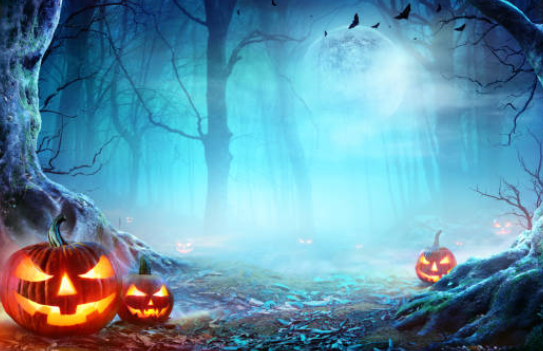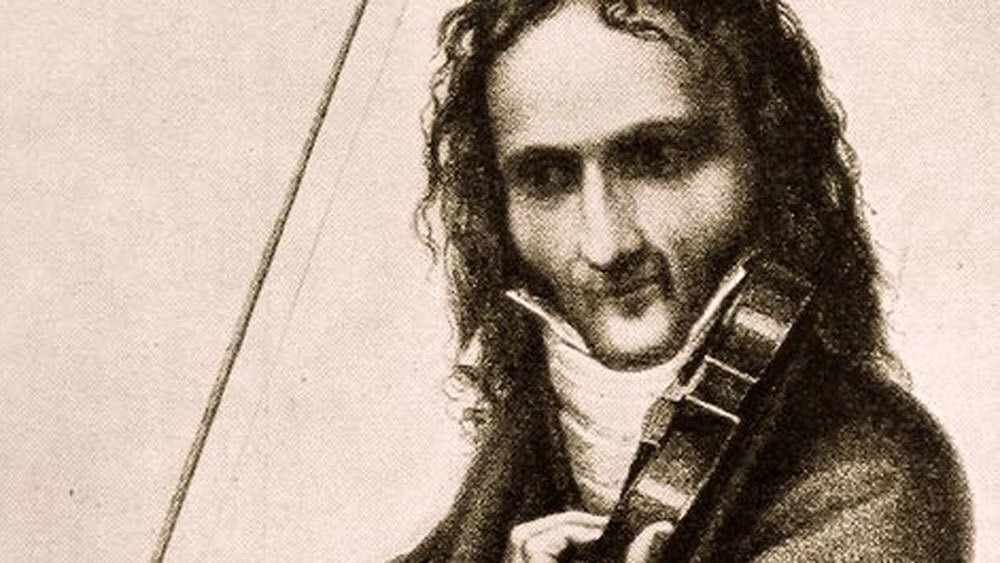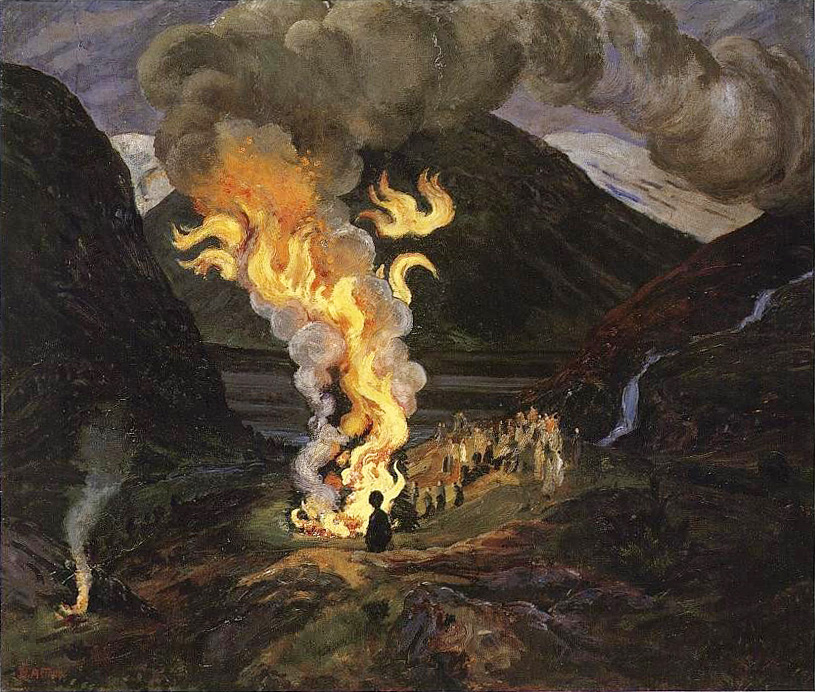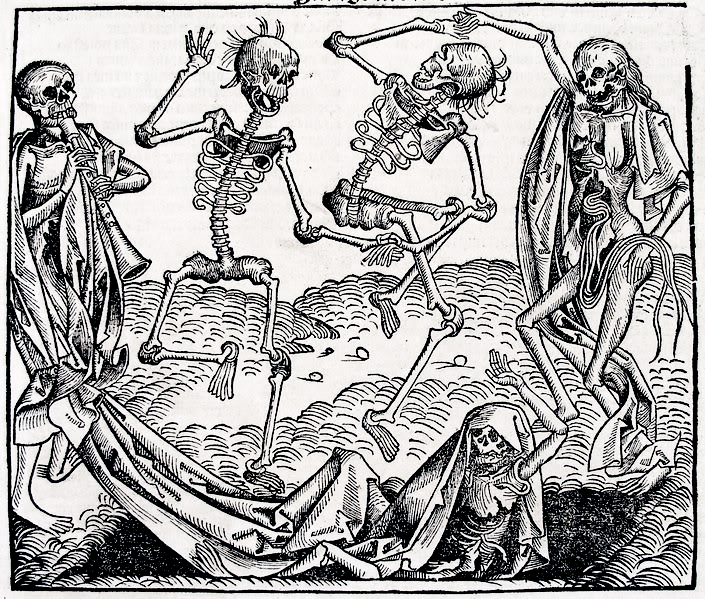
Bach – Toccata in D Minor (1708)
Probably the most famous piece of organ music written, the Toccata and Fugue in D minor was not intended to be creepy, but thanks to its use in numerous films, it has become a cliché to illustrate horror and villainy.
Franz Schubert – Erlkönig (1815)
This suspenseful Lied recounts a conversation between a son and his father on horseback. Despite his father’s attempts to console him, the boy fears pursuit by the mysterious “Erlkönig” (sometimes translated as “Elf-King”).
Who rides so late through the night and wind?
It is the father with his child.
He has the boy in his arms;
he holds him safely, he keeps him warm.
‘My son, why do you hide your face in fear?’
‘Father, can you not see the Erlking?
The Erlking with his crown and tail?’
‘My son, it is a streak of mist.’
‘Sweet child, come with me.
I’ll play wonderful games with you.
Many a pretty flower grows on the shore;
my mother has many a golden robe.’
‘Father, father, do you not hear
what the Erlking softly promises me?’
‘Calm, be calm, my child:
the wind is rustling in the withered leaves.’
‘Won’t you come with me, my fine lad?
My daughters shall wait upon you;
my daughters lead the nightly dance,
and will rock you, and dance, and sing you to sleep.’
‘Father, father, can you not see
Erlking’s daughters there in the darkness?’
‘My son, my son, I can see clearly:
it is the old grey willows gleaming.’
‘I love you, your fair form allures me,
and if you don’t come willingly, I’ll use force.’
‘Father, father, now he’s seizing me!
The Erlking has hurt me!’
The father shudders, he rides swiftly,
he holds the moaning child in his arms;
with desperate effort he reaches home;
in his arms the child lay dead.
Niccolò Paganini (1782-1840)
La Campanella (1826)

By Age 18, Paganini was appointed first violin of the Republic of Lucca in Italy, but a substantial portion of his income came from freelancing. He was an astonishingly talent violinist with perfect technique, flying fingers and a fervent, emotional style of playing that drove audiences wild. A shameless self-promoter, he completely changed the nature of violin playing.
Some of the wild rumors that circulated about him were that he learned to play while spending 8 years in a dungeon for stabbing one of his rivals, that he cut off his lover’s head, and that he sold his soul to the devil. He actually confided to the German author Heinrich Heine that the devil led him by the hand, and, as a result, the Catholic church refused him a religious funeral or burial in consecrated ground.
Modest Mussorgsky – Night on Bald Mountain (1867)

Originally titled “St. John’s Night on the Bare Mountain,” this piece evokes the pagan festivities of the midsummer Slavic holiday associated with the summer solstice involving fire, water and fertility rituals, as well as the gathering of witches and spirits. The name of St. John became attached to the ancient holiday when the Christian church attempted to appropriate and alter the celebrations.
As with so much of Mussorgsky’s music, the work had a tortuous compositional history and was arranged after his death by his friend Rimsky-Korsakov. It was never performed in any form during Mussorgsky’s lifetime.
Giuseppe Verdi – Dies Irae from his Requiem (1873-74)
When it comes to spine-chilling music, it’s hard to beat Verdi’s Dies Irae, or ‘Day of Wrath’. Verdi’s Requiem is an epic achievement in every sense, but this depiction of the Biblical day of judgement is pretty unsettling stuff.
Franz Liszt – Mephisto Waltz (1881)
A wedding feast is in progress in a village inn with music, dancing and carousing. Mephistopheles and Faust pass by and Faust is induced to enter and take part in the festivities. Mephistopheles snatches the fiddle from the hands of a lethargic fiddler and draws from it indescribably seductive and intoxicating strains. The amorous Faust whirls about with a full-blooded village beauty in a wild dance. They waltz in mad abandon out of the room, into the open and away into the woods. The sounds of the fiddle grow softer and softer, and the nightingale warbles his love-laden song.
Charles Gounod – Funeral March of a Marionette (1872)
Ok. One listen to this piece and you’ll instantly recognize it as the theme for Alfred Hitchcock Presents. However, it has also a great piece for Halloween because of its subject matter (a funeral) and it’s oddly catchy and creepy melody. The storyline that the piece follows is that a marionette has died in a duel, the funeral procession commences, and then, during the central section, mourners take refreshments before returning to the march.
Aaron Copland – Grohg (1922-24)
An adaptation of the Dracula tale, and inspired by the film Nosferatu, Copland completed Grohg around 1925. The music uses jazzy syncopations and cheery melodies with sinister undertones to add to the feel of unease.
John Barnes Chance – Incantation and Dance (1960)
John Barnes Chance (1932-1972) was born in Texas, where he played percussion in high school. His early interest in music led him to the University of Texas at Austin, where he received his bachelor’s and master’s degrees. He produced seven works for school ensembles, including his classic Incantation and Dance.
The title of this work suggests a religious orientation, but not towards any of the established religions of a Western or Eastern culture. Incantations are uttered in rituals of magic and the conjuring up of spirits, evil and benign. The opening Incantation is full of mystery and expectation, wandering, and unstable. The Dance also begins quietly, but percussion instruments quickly begin, one by one, to drive a rhythmic pattern of incredible complexity and drive. As other instruments are added, the dance grows wilder and more frenzied.
Camille Saint-Saëns – Danse Macabre (1874)
Personified Death leading a row of dancing figures from all walks of life to the grave. According to superstition, Death appears at midnight every year on Halloween (signaled by 12 notes from the harp). Death has the power to call forth the dead from their graves to dance from him while he plays his fiddle. His skeletons dance for him until the first break of dawn, when they must return to their graves until the next year. The piece makes particular use of the xylophone to imitate the sound of rattling bones. When first premiered, it was not received well. Audiences were quite unsettled by the disturbing, yet innovative, sounds that Saint-Saens elicited. Shortly thereafter, it was transcribed by Franz Liszt who recognized its genius and greeted it with much enthusiasm
